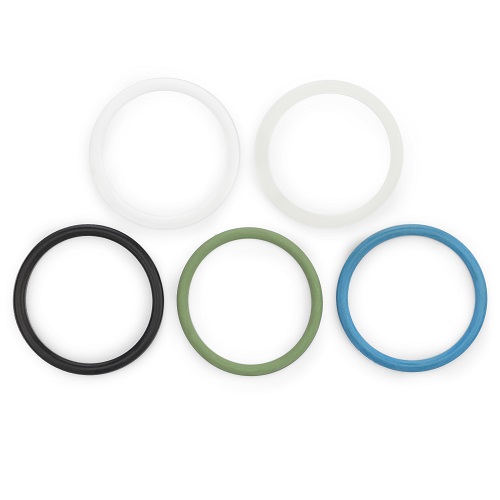Tri-Clamp Gasket Cleaning and Maintenance
One of the most overlooked pieces of equipment in your sanitary process lines is the lowly Tri-Clamp gasket. Perhaps you don’t give it much thought, but this little piece is crucial for maintaining a leak-proof system.
If not properly cleaned and maintained, the tri-clamp gasket can be the source of huge problems including the contamination and loss of an entire batch of processed goods.

The stainless steel fittings in your processing equipment should last a very long time. However, tri-clamp gaskets wear down requiring them to be replaced much more frequently than their stainless steel counterparts.
Frequent handling during line maintenance, coupled with periods of wet and dry cycling all lead to degradation of gaskets over time. The good news is that gaskets happen to be one of the cheapest parts within your sanitary process line. This makes it attractive to swap out or replace gaskets at a greater frequency than any other parts.

This article will cover everything you need to know with regards to your tri-clamp gaskets including:
- Inspection of tri-clamp gaskets
- Cleaning and caring for gaskets
- Best practices for gasket maintenance
Inspecting Tri-Clamp Gaskets
Whenever you’re disassembling your process line take a few additional seconds to give your gaskets a quick look. Here are some of the things we recommend keeping an eye out for:
- Cracked or torn gaskets
- Deformities or misshaped sections
- Build up of product residue
- Bent or flat spots on the raised positioning ring (the part that sits in the tri-clamp groove)
If any of these are noted it’s a best practice to replace the gasket as soon as possible.
When reassembling a tri-clamp connection, make sure that the gasket sits flush into the grooves of the flange faces. A gasket that will not sit properly should also be replaced.
Depending on the material, a gasket should be slightly pliable, allowing for some bend when gently squeezed. If you cannot bend the gasket, or it cracks when doing so, this is also a sign that a replacement is needed.
With regards to the cleanliness of gaskets, remember that just because you cannot see built-up residue does not mean that microscopic materials are present. This shouldn’t be the case with a perfectly sealed gasket but this isn’t always easy to spot.
Cleaning and Caring for Tri-Clamp Gaskets
Cleaning your gaskets should be a two-step process. For the first step, we recommend cleaning your gaskets by soaking them in an alkaline solution such as PBW or similar products. This will clean the gaskets of any material that may have collected over time.
The second step in the cleaning process is to use a sanitizing solution such as StarSan, or similar products. This will sanitize your gaskets making them acceptable to come in contact with food and beverage products.
Depending on your industry, advanced cleaning agents and processes may be required. The directions above are absolute minimum best practices. In all cases, please follow manufacturer recommendations when using cleaning products.
Best Practices for Tri-Clamp Gasket Maintenance
We recommend checking gaskets on a regular basis as part of a system maintenance schedule. How often you check these connections depends upon what you’re processing, how often, and when. For some companies, this may be after every production run. In other cases, it may be a couple of days or weeks between inspections.
As part of this article, we reached out to a couple of manufacturers in a variety of industries to see what their processes look like with regards to gasket care and maintenance.
Adam Lawrence of Left Hand Brewing offered the following procedures:
- Silicon gaskets that are used with hoses are inspected with every use
- Tubing Teflon gaskets are inspected and replaced with every use
- Torn or stained gaskets are replaced immediately
- Tubing Teflon gaskets are replaced with every breakdown
- Cleaning includes scrubbing with chlorinated caustic and rinsing
With the need to replace gaskets early and often it’s a good idea to have plenty of backup stock on hand. Tri-Clamp gasket manufacturer RubberFab recommends the following for safe storage of gaskets when not in use:
- Maintain temperatures below 77-Degrees Fahrenheit
- Dry environment, with little to no humidity
- Protected from light, especially sunlight
- Sealed and protected from open-air conditions
- Laying flat, neutral, or relaxed position
Conclusion
Tri-Clamp gaskets are one of the cheapest pieces of equipment in your manufacturing process line. However, this does not mean that you can afford to ignore them. Regular inspection, cleaning, and replacement of your gaskets is one of the easiest ways to maintain a leak-proof and sanitary process line.
For more information or additional questions, please contact us.

